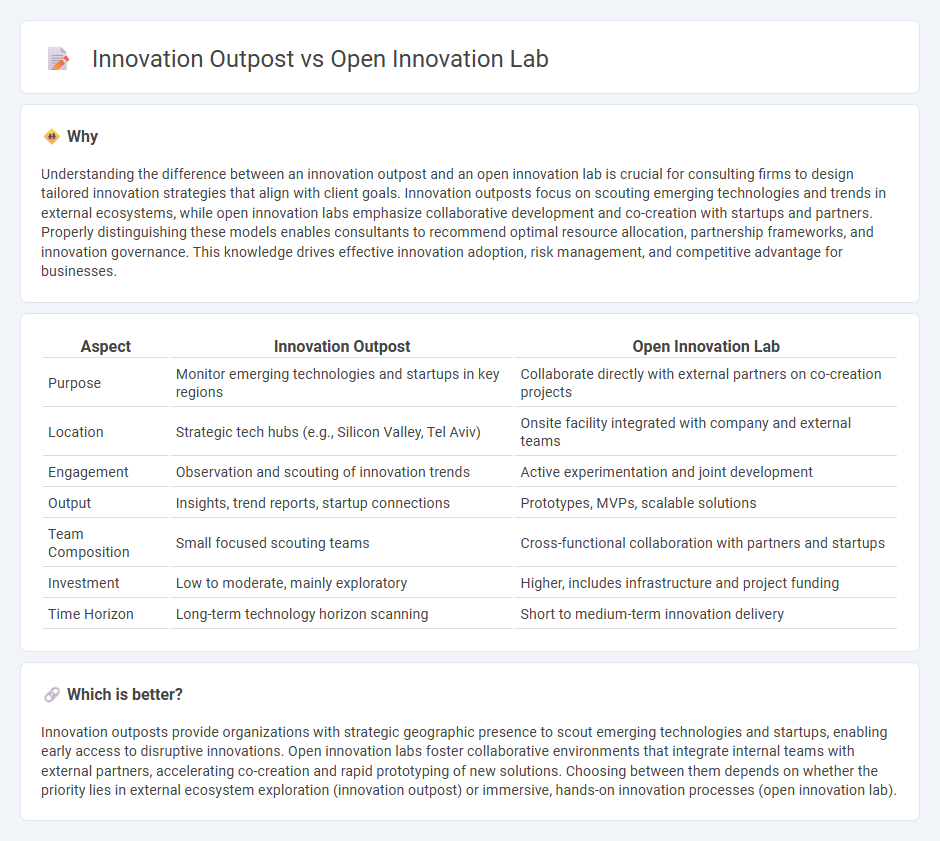
Consulting firms often differentiate between innovation outposts and open innovation labs to enhance corporate innovation strategies. Innovation outposts serve as remote hubs embedded within startup ecosystems to identify emerging technologies, while open innovation labs foster collaborative environments that integrate external partners and internal teams for co-creating solutions. Explore how these models can accelerate your company's innovation objectives.
Why it is important
Understanding the difference between an innovation outpost and an open innovation lab is crucial for consulting firms to design tailored innovation strategies that align with client goals. Innovation outposts focus on scouting emerging technologies and trends in external ecosystems, while open innovation labs emphasize collaborative development and co-creation with startups and partners. Properly distinguishing these models enables consultants to recommend optimal resource allocation, partnership frameworks, and innovation governance. This knowledge drives effective innovation adoption, risk management, and competitive advantage for businesses.
Comparison Table
| Aspect | Innovation Outpost | Open Innovation Lab |
|---|---|---|
| Purpose | Monitor emerging technologies and startups in key regions | Collaborate directly with external partners on co-creation projects |
| Location | Strategic tech hubs (e.g., Silicon Valley, Tel Aviv) | Onsite facility integrated with company and external teams |
| Engagement | Observation and scouting of innovation trends | Active experimentation and joint development |
| Output | Insights, trend reports, startup connections | Prototypes, MVPs, scalable solutions |
| Team Composition | Small focused scouting teams | Cross-functional collaboration with partners and startups |
| Investment | Low to moderate, mainly exploratory | Higher, includes infrastructure and project funding |
| Time Horizon | Long-term technology horizon scanning | Short to medium-term innovation delivery |
Which is better?
Innovation outposts provide organizations with strategic geographic presence to scout emerging technologies and startups, enabling early access to disruptive innovations. Open innovation labs foster collaborative environments that integrate internal teams with external partners, accelerating co-creation and rapid prototyping of new solutions. Choosing between them depends on whether the priority lies in external ecosystem exploration (innovation outpost) or immersive, hands-on innovation processes (open innovation lab).
Connection
Innovation outposts and open innovation labs are connected through their shared goal of accelerating business transformation by leveraging external ideas and technologies. Innovation outposts serve as strategic hubs in key ecosystems to scout emerging trends and startups, while open innovation labs provide collaborative spaces for co-creating solutions with partners, startups, and internal teams. Together, they enable organizations to integrate cutting-edge innovations rapidly, reduce time-to-market, and enhance competitive advantage.
Key Terms
Collaboration Ecosystem
An open innovation lab fosters a collaborative ecosystem by inviting external partners, startups, and academics to co-create and develop solutions within a shared physical or digital space. Innovation outposts are strategically located hubs, often in innovation hotspots, designed to monitor emerging trends, build local partnerships, and accelerate knowledge transfer between global headquarters and regional innovators. Explore further to understand how each model enhances collaboration and drives innovation success.
Technology Scouting
An open innovation lab serves as a collaborative environment where startups, researchers, and corporate teams co-develop cutting-edge technologies, emphasizing hands-on experimentation and quick prototyping. An innovation outpost functions primarily as an external scouting hub located in key innovation ecosystems, focusing on identifying emerging technologies, startups, and trends for strategic insights. Explore deeper comparisons to leverage the right model for technology scouting in your organization.
External Partnerships
Open innovation labs function as collaborative hubs within organizations to co-develop new technologies by leveraging diverse external expertise, startups, and academic institutions. Innovation outposts are strategically located units near innovation hotspots to scout emerging trends and form partnerships that accelerate access to novel technologies and market opportunities. Explore the distinct approaches of open innovation labs and innovation outposts to enhance your external partnership strategies.
Source and External Links
Open Innovation at EDF Innovation Lab - The EDF Innovation Lab uses collaborative partnerships with external organizations to generate and accelerate new ideas and solutions, focusing on co-innovation rather than equity investment, and provides partners with real business use cases and access to industry experts.
Design an Open Innovation Lab for Lasting Value - An Open Innovation Lab is a structured environment designed to inspire new ways of working, drive rapid innovation, and break down internal silos by using a customizable canvas to align objectives, operational models, and methodologies with business goals.
Open Innovation Lab - Engineering tools for open automotive innovation - This project developed open, license-free simulation tools and platforms for automotive software innovation, emphasizing interoperability and standards to overcome the limitations of proprietary systems.
 dowidth.com
dowidth.com